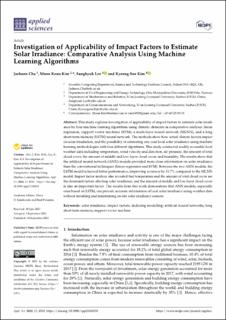| dc.contributor.author | Cha, Jaehoon | |
| dc.contributor.author | Kim, Moon Keun | |
| dc.contributor.author | Lee, Sanghyuk | |
| dc.contributor.author | Kim, Kyeong Soo | |
| dc.coverage.spatial | China | en_US |
| dc.date.accessioned | 2022-12-06T12:22:12Z | |
| dc.date.available | 2022-12-06T12:22:12Z | |
| dc.date.created | 2021-09-14T14:34:27Z | |
| dc.date.issued | 2021 | |
| dc.identifier.issn | 2076-3417 | |
| dc.identifier.uri | https://hdl.handle.net/11250/3036124 | |
| dc.description.abstract | This study explores investigation of applicability of impact factors to estimate solar irradiance by four machine learning algorithms using climatic elements as comparative analysis: linear regression, support vector machines (SVM), a multi-layer neural network (MLNN), and a long short-term memory (LSTM) neural network. The methods show how actual climate factors impact on solar irradiation, and the possibility of estimating one year local solar irradiance using machine learning methodologies with four different algorithms. This study conducted readily accessible local weather data including temperature, wind velocity and direction, air pressure, the amount of total cloud cover, the amount of middle and low-layer cloud cover, and humidity. The results show that the artificial neural network (ANN) models provided more close information on solar irradiance than the conventional techniques (linear regression and SVM). Between the two ANN models, the LSTM model achieved better performance, improving accuracy by 31.7% compared to the MLNN model. Impact factor analysis also revealed that temperature and the amount of total cloud cover are the dominant factors affecting solar irradiance, and the amount of middle and low-layer cloud cover is also an important factor. The results from this work demonstrate that ANN models, especially ones based on LSTM, can provide accurate information of local solar irradiance using weather data without installing and maintaining on-site solar irradiance sensors. | en_US |
| dc.description.sponsorship | This work was supported by Oslo Metropolitan University and part by Xi’an Jiaotong-Liverpool University Centre for Smart Grid and Information Convergence (CeSGIC). | en_US |
| dc.language.iso | eng | en_US |
| dc.publisher | MDPI | en_US |
| dc.relation.ispartofseries | Applied Sciences;Volume 11 / Issue 18 | |
| dc.rights | Navngivelse 4.0 Internasjonal | * |
| dc.rights.uri | http://creativecommons.org/licenses/by/4.0/deed.no | * |
| dc.subject | Solar irradiance | en_US |
| dc.subject | Impact factors | en_US |
| dc.subject | Deducing modelling | en_US |
| dc.subject | Artificial neural networks | en_US |
| dc.subject | Long short-term memories | en_US |
| dc.subject | Support vector machines | en_US |
| dc.title | Investigation of Applicability of Impact Factors to Estimate Solar Irradiance: Comparative Analysis Using Machine Learning Algorithms | en_US |
| dc.type | Peer reviewed | en_US |
| dc.type | Journal article | en_US |
| dc.description.version | publishedVersion | en_US |
| dc.source.articlenumber | 8533 | en_US |
| cristin.ispublished | true | |
| cristin.fulltext | original | |
| cristin.qualitycode | 1 | |
| dc.identifier.doi | https://doi.org/10.3390/app11188533 | |
| dc.identifier.cristin | 1934226 | |
| dc.source.journal | Applied Sciences | en_US |
| dc.source.volume | 11 | en_US |
| dc.source.issue | 18 | en_US |
| dc.source.pagenumber | 1-17 | en_US |

